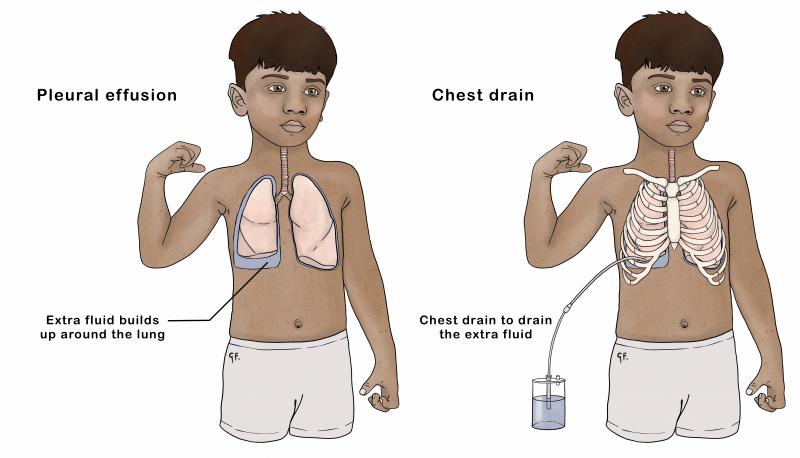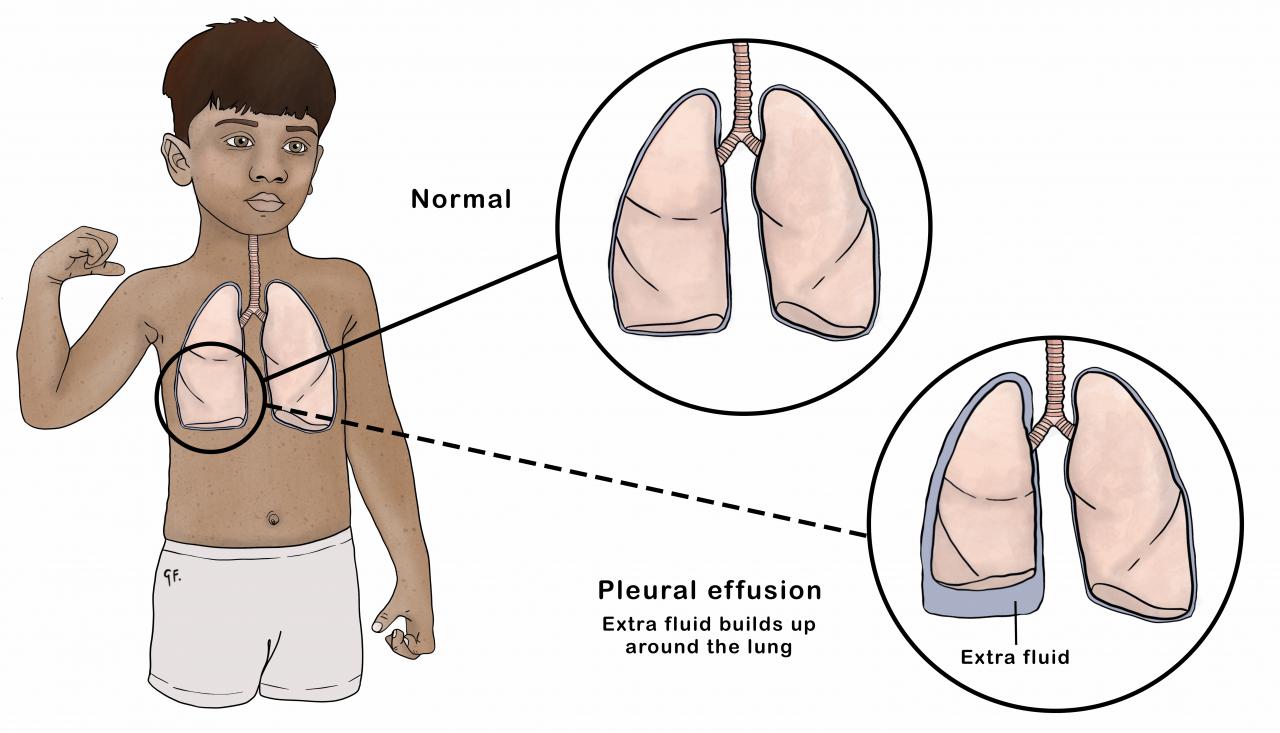Pleural Effusion & Empyema In Children
Pleural Effusion & Empyema In Children
A pleural effusion is when extra fluid builds up in the space around the lungs. The most common cause of pleural effusion is pneumonia, an infection of the lungs.
Key points about pleural effusion and empyema
- a pleural effusion is when extra fluid builds up around the lung
- empyema is when the fluid around the lung gets very thick
- the most common cause of pleural effusion in tamariki (children) is pneumonia
What is a pleural effusion?
It’s normal to have a small amount of fluid around the lungs. A pleural effusion is when more fluid than normal builds up in the space between the lungs and the chest wall. This space is called the pleural cavity.

Causes of pleural effusion
The most common cause of pleural effusion in tamariki is pneumonia. Pneumonia is an infection of the lungs.
Pleural effusion in tamariki can also be caused by:
- injury or trauma to the lung
- liver problems
- kidney problems
- inflammation of the pancreas (pancreatitis)
- the heart not pumping properly (heart failure)
- malnutrition
- some types of surgery to the chest or heart
- some very rare conditions
Your child’s doctor will tell you if they think the effusion is due to pneumonia or something else.
See the KidsHealth page on pneumonia for more information.
Symptoms of pleural effusion
If an effusion is building up, tamariki may have a change in symptoms even after several days of pneumonia treatment. This may include:
- a cough that’s not getting better
- faster breathing rate
- sharp chest pain that is worse when taking deep breaths
- a fever that is not settling down
Diagnosis of a pleural effusion
A chest x-ray is needed to show a pleural effusion. Tamariki may also have an ultrasound scan of their chest. This helps the doctor decide the best way to treat their pleural effusion.
See the KidsHealth page on x-ray to learn more.
See the KidsHealth page on ultrasound scans to learn more.
Treatment of pleural effusion
A small pleural effusion will usually get better on its own once the pneumonia has been treated. A health professional will prescribe antibiotics to treat the pneumonia.
If a pleural effusion is large or it has become an empyema, your child may need added treatment. Your child may need a chest drain. A chest drain is a thin tube that doctors put through a small cut in between your child’s ribs. Your child will be asleep during this procedure. A chest drain can help drain out the extra fluid around the lungs.

What is empyema?
Empyema happens when the extra fluid around the lung becomes thick and sludgy.

Tamariki with empyema will take longer to get better than tamariki with a pleural effusion.
Symptoms of empyema
Doctors may look for empyema when tamariki with pneumonia don’t get better as quickly as expected. Tamariki with empyema may have breathing troubles, ongoing fevers, chest pain or a continuing cough. They may prefer to lie on their side.
Diagnosis of empyema
Tamariki will need an ultrasound scan of the chest to show empyema.
See the KidsHealth page on ultrasound to learn more.
Treatment of empyema
Tamariki with empyema may need a chest drain. A chest drain is a thin tube that doctors put through a small cut in between your child’s ribs. Your child will be asleep during this procedure. A chest drain can help drain out the extra fluid around the lungs.
A medicine called urokinase can be put into a chest drain to help break down the thick fluid.
Rarely, tamariki may need keyhole surgery to clear away the empyema. Your child will be asleep during this procedure. If your child needs this procedure, they will also have a chest drain left in place for a few days.
Chest drains
Having a drain can speed up the time until tamariki can leave hospital.
The drain usually stays in for several days. A member of your child’s healthcare team will remove it before they go home.
After going home from hospital, it can still take your child several weeks to get completely better.
Not all tamariki will need a chest drain. Your child’s doctor will talk about the advantages and disadvantages of doing a chest drain for your child, to help you decide.
Effects of a pleural effusion or empyema
Small pleural effusion or empyema
Tamariki with a small pleural effusion or empyema may be unwell for 1 to 2 weeks longer than tamariki with just pneumonia. Most tamariki with an effusion or empyema get better with no long-term problems.
While your child has a pleural effusion or empyema, they can have ongoing fevers. This is not harmful to most tamariki.
Larger pleural effusion or empyema
If your child has a larger effusion or empyema, it can sometimes squash some of the lung. Your child may need oxygen, through nasal prongs or a mask.
If your child has a chest drain or keyhole surgery, they may have some pain for a few days after the procedure. The health professionals caring for your child can give them pain medicine.
Once tamariki can move about, this will speed up getting better.
Long-term effects of a pleural effusion or empyema
Tamariki are expected to make a very good recovery after having an effusion or empyema.
Some tamariki have a little bit of scarring in the lungs afterwards but, almost always, this does not cause any long-term problems for their health.
Your child’s doctors will tell you if any special follow-up is needed after you go home.
This page last reviewed 07 November 2024.
Do you have any feedback for KidsHealth?
If you have any feedback about the KidsHealth website, or have a suggestion for new content, please get in touch with us.
Email us now
